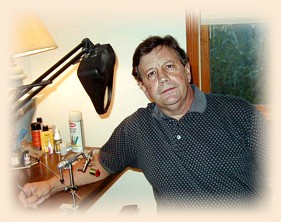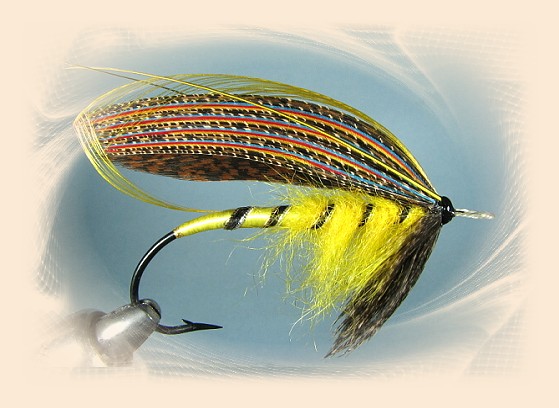This is one of several flies from the Victorian Age that sports a military theme, which is as it
should be, as a great number of the salmon fishermen of that period were military men. There were flies
named the Major, the Colonel, and the Captain, but no Lieutenants, and certainly no Corporals or Privates.
The General would have to wait for a trip across the Atlantic, and would finally find a fly cleverly named
General Hooker here in America, and the General Money in British Columbia, Canada.
Francis Francis, in his work A Book on Angling picks up on the military theme quite nicely with his
description of the Colonel found in the "List of Flies for Scotch Rivers" section of the book:
"There are two uniforms which the colonel rejoices in; the one a bright
gold or yellow, and the other a red gold, or orange."
Francis Francis then goes on to describe two flies, one with a more yellow tone, and one with an overall orange
coloration. Francis Francis lists the Colonel not in association with a specific river, but as a fly good at times
for all of them, the Silver Doctor, Major, Ranger flies, Parson, Butcher, Childers, Black and Teal, and Popham,
rounding out the list. This is a list comprising some of the most celebrated salmon flies of the gilded age,
and a fly had to be a good one to make this cut. Flies listed elsewhere in the book are more river specific,
but these were the flies that worked anywhere.
There is a more modern version of the Colonel, and that is the one I've done above. It's first listed in Kelson's
The Salmon Fly, and that recipe goes on to be repeated in Hardy and Hale. Kelson liked the fly for
the rivers Thurso, Don, and Wye.
My rendition of the fly is strictly a showpiece, and not meant in any way to represent the flies actually used
back in the Gilded Age. The fly sports a married wing consisting of 54 individual married strands, 27 a side. The first one
of these I did had a wing of 48 single strands, but when all was said and done I decided the wing was too high,
and looked out of proportion. So I lowered the wing on the second one, but inexplicably made it even larger strand-wise
at the same time. All in all I made five of these wings, three lefts and two rights, as one fell apart as I was trying to mount it on the
first fly. As an exercise, this fly was all I could ask for. The very difficult section is actually the body, especially
around the tail, as there is no butt section to hide material ends, so getting a smooth look takes some doing.
So if you're really feeling crazy, try this fly on for size. I'll start you off with my version of the wing. The
sections are comprised of bustard, golden pheasant tail, bustard, yellow, red and blue swan, repeated several times.
You can easily go for 60 total, 30 a side, but I found that I just couldn't mount the wing successfully at that
size. It's the golden pheasant tail. It doesn't marry well, even to bustard. Maybe next time I'll go for 60. Have fun
with this one.
Colonel (Hardy)
Tag: Gold tinsel; Yellow floss
Tail: Topping
Butt: Black ostrich herl
body: Two turns yellow floss, followed by yellow seal's fur
Ribs: Black purse floss; Gold lace and silver tinsel
Hackle: Yellow
Throat: Light bustard
Wings: Strips of dark mottled turkey; Golden pheasant tail; bustard; Yellow, red and blue swan; Topping
Horns: Blue Macaw
Head: Black
Credits: Classic Salmon Flies by Mikael Frodin;
Salmon Fishing by John James Hardy;
A Book on Angling by Francis Francis;
~ EA
About Eric:
 Eric lives in Delaware, Ohio and fishes for brown trout in the Mad River,
a beautiful spring creek. More of his flies are on display here:
traditionalflies.com -- Classic salmon and
trout flies of Europe and the Americas.
Eric lives in Delaware, Ohio and fishes for brown trout in the Mad River,
a beautiful spring creek. More of his flies are on display here:
traditionalflies.com -- Classic salmon and
trout flies of Europe and the Americas.
|


 Eric lives in Delaware, Ohio and fishes for brown trout in the Mad River,
a beautiful spring creek. More of his flies are on display here:
traditionalflies.com -- Classic salmon and
trout flies of Europe and the Americas.
Eric lives in Delaware, Ohio and fishes for brown trout in the Mad River,
a beautiful spring creek. More of his flies are on display here:
traditionalflies.com -- Classic salmon and
trout flies of Europe and the Americas.